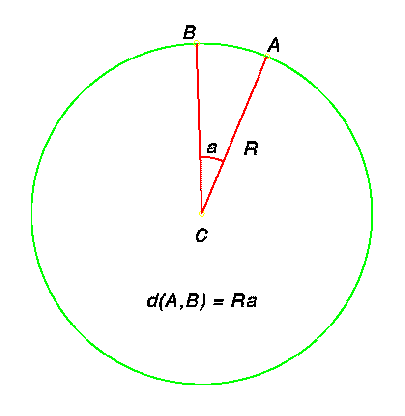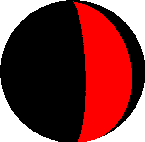


If A and B are antipodal points, then A, B, and C lie on the same line in space. Any plane which contains this line determines a great circle which must contain A and B. Thus there are infinitely many great circles containing A and B if they are antipodal.
To sum up, the first incidence relation for the sphere is:
 If A and B
are two points on the sphere, then the distance between them is the
distance along the great circle connecting them. Since this circle
lies totally in a plane, we can figure this distance using the plane
figure to our left. If the angle ACB is a, and
if a is measured in radians,
then the distance between
A and B is given by
If A and B
are two points on the sphere, then the distance between them is the
distance along the great circle connecting them. Since this circle
lies totally in a plane, we can figure this distance using the plane
figure to our left. If the angle ACB is a, and
if a is measured in radians,
then the distance between
A and B is given by
where R is the radius of the sphere.
An isometry of the sphere is a mapping of the sphere to itself which preserves the distance between points. It is easy to see that a rotation of the sphere around one of the sphere's diameters is an isometry. It simply rotates the picture to the left into another one just like it, but in a different plane.
Another example of an isometry is the antipodal map, which
maps a point onto the point on the other side of the sphere. In other
words, given a point A on the sphere, its image under the
antipodal map is the other intersection of the line AC through
the point A and the center of the sphere C, with
the sphere.
 In the plane the simplest polygon is the triangle. There are no
interesting polygons with only two sides. This is not true on the
sphere. Any two great circles meet in two antipodal points, and
divide the sphere into four regions each of which has two sides which
are segments of great circles. We will call such a region a
lune, or a biangle.
In the plane the simplest polygon is the triangle. There are no
interesting polygons with only two sides. This is not true on the
sphere. Any two great circles meet in two antipodal points, and
divide the sphere into four regions each of which has two sides which
are segments of great circles. We will call such a region a
lune, or a biangle.
Why is it called a lune? The name comes from the Latin word luna, which means moon. Think about the part of the moon that is seen at any time. That portion has to be in the hemisphere which is illuminated by the sun, and in the hemisphere that is visible from the earth. The intersection of two hemispheres is precisely a lune.
Lunes are pretty simple things. However there are two things we should notice about them.
We should mention that in these notes all angles will be measured in radians.
With a protractor and a little practise it is possible to measure spherical angles pretty accurately. In the case of a lune, the angle between the great circles at either of the vertices is simply the angle between the planes that define the great circles, and so it does not matter at which vertex the measurement is made.
 |
The next section contains a discussion of area on the sphere. |
 |
The previous section discusses the basic properties of spheres. |
 |
Table of Contents. |